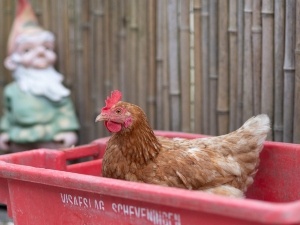
If a chicken were to injure itself, externally, it would be very easy to tell that the bird is hurt and it would be very easy to treat the bird, internal bleeding is not the same. You may not notice if a bird has internal bleeding.
Internal bleeding is very dangerous for a bird and this should be addressed as soon as possible. This article looks into how to tell if a chicken has internal bleeding.
Table of Contents
How to tell if a chicken has internal bleeding:
Chickens are quite fragile, these animals can injure themselves very easily and a loss of too much blood can kill the bird, even if this blood loss happens because of internal bleeding. This is how to tell if a bird has internal bleeding:
Bruising:
If your chicken was recently injured or was in a collision and the bird has bruising, then the bird may have internal bleeding.
Bruising on chickens will look green, it will not look red or purple like a human bruise will.
A chicken bruise will look green because a green pigment called biliverdin accumulates in the area when the bird’s hemoglobin is broken down. Hemoglobin starts to break down in the area a couple of days after the injury.
You may only notice the bruising on your bird’s skin 2-3 days after the bird becomes injured.
Blood in poop:
Red poop can mean a number of things but it can also mean that the bird has an internal injury and is bleeding from its vent because of this.
A chicken can start to bleed from its vent if it ruptures a blood vessel in its vent, or, if an egg breaks in its body and the sharp eggshell cut the bird’s insides. Both of these scenarios can be extremely dangerous for the bird.
What to do:
Take your bird to the vet as soon as you see the above signs of internal bleeding. Internal bleeding in chickens is considered a state of emergency and needs to be dealt with by a professional as soon as possible.
The vet will examine your bird and run tests to confirm the internal bleeding suspicion and then treat the bird accordingly.
When you get home:
After coming back from the vet, make sure to keep the bird safe and isolated. Doing this will give the bird the opportunity to recover without other birds pecking at it or stressing it.
Keep the isolation space warm and dark, and make sure that the bird has access to its own food and water while in isolation.
Give electrolytes to your bird to help it with healing, only offer electrolytes for a few days. Electrolytes will help with stress management after the injury.
You can buy electrolyte solutions online or in-store, or, you can make an electrolyte solution at home
Tip:
You’d need to examine the bird to check if the bird is bruised or pooping blood, but you’d need to get ahold of the bird first.
Gently catch the chicken but avoid chasing the bird to catch it. Chasing the bird will only stress the bird which is dangerous for it, especially when it’s internally bleeding
If you enjoyed this article then you may also be interested in other chicken related articles. Here are some articles that you may be interested in: Chicken Is Spinning In Circles, Sick Chicken Head Twitching, Chicken Hanging Head Down, Lime Vs Diatomaceous Earth For Chickens, Chicken Preening Or Itching

